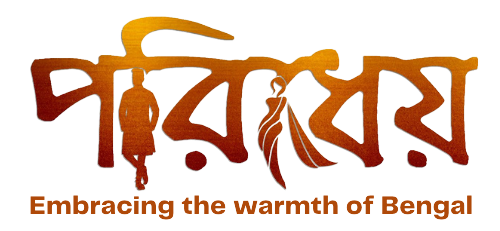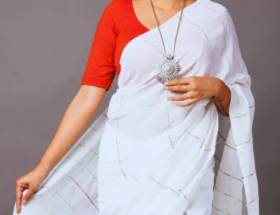Indian Fabrics – A Journey Through Enchanting World
In the vibrant tapestry of Indian fabrics, an array of materials unfolds, each with its own story to tell. From the lustrous silks that shimmer like moonlight to the soft cotton that breathes life into every thread, these fabrics embody the rich heritage and diversity of India. Let us embark on a poetic journey through the enchanting realm of Indian textiles, exploring the emotions and artistry woven into each fabric.
Silk – The Epitome of Luxury of Indian Fabric
Silk, the queen of fabrics, reigns supreme with its beauty and luxurious touch. Its smooth texture and natural sheen exude elegance and opulence. Artisans craft each variant, from the regal Banarasi silk to the resplendent Kanchipuram silk, into a masterpiece. With each drape, silk sarees envelop the wearer in a tapestry of grace and allure, carrying the legacy of centuries-old traditions.
Cotton – The Comfortable Classic
Cotton, the breath of nature, embraces us with its gentle touch and lightweight comfort. It is the fabric of everyday life, woven into the very fabric of Indian culture. From the softness of Chanderi cotton to the vibrant hues of Maheshwari cotton, cotton sarees embody simplicity and elegance. With every fold, they whisper stories of resilience and harmony with the land, wrapping the wearer in a cocoon of natural beauty.
Linen – Light and Breathable
Linen, the embodiment of serenity, weaves an enchanting tale of tranquility and sophistication. Its cool touch and delicate weave evoke a sense of calm and timeless beauty. Linen sarees, such as the Malmal cotton saree and the Tant cotton saree, drape the wearer in an ethereal charm, reflecting their innermost desires and emotions. Like a gentle breeze, linen fabric caresses the skin, creating a serene and poetic aura.
Georgette- Epitome of Grace in Indian Fabrics
Georgette, the epitome of grace, dances with the movement, infusing each step with elegance and allure. Its lightweight texture and flowing drape add a touch of romance to any occasion. Georgette sarees, like the Kota Doria cotton saree and the Tussar silk saree, evoke a timeless charm that captures the essence of femininity and poise. With their sheer fabric and subtle sheen, they serve as the canvas on which people paint their dreams and desires.
Chiffon – Essence of Romance in Indian Fabrics
Chiffon, the essence of romance, floats on the breeze, embodying a delicate and ethereal beauty. It’s sheer fabric and soft drape lend an air of enchantment to the gesture. Chiffon sarees evoke emotions of love and passion, weaving a story of elegance and allure. With every sway, chiffon fabric enchants the beholder, casting a spell of grace and beauty.
Velvet – Embodiment of luxury in Indian Fabrics
Velvet, the embodiment of luxury, envelopes you with its plush texture and regal aura. Its rich depth and velvety touch exude opulence and grandeur. Velvet sarees, like the Banarasi velvet saree and the Kashmiri velvet saree, elevate the wearer to a realm of sophistication and splendor. With their intricate embellishments and sumptuous feel, they become an expression of timeless elegance and aristocratic charm.
Wool – Warmth and Elegance Combined
Wool, the warmth of winter, embraces us with its cozy embrace and softness. It is the fabric that protects and comforts during the chilly months. From the intricate patterns of Pashmina shawls to the rustic charm of woolen sarees, the wool becomes a companion in the cold, enveloping the wearer in a cocoon of warmth and comfort.
Satin – the embodiment of sensuality
Satin, the embodiment of sensuality, drapes the body with its smoothness and lustrous sheen. Its silky touch evokes a sense of intimacy and desire, making every movement a sensual dance. Satin sarees, like the Bhagalpuri silk saree and the Bomkai silk saree, become a canvas for expressing passion and allure. With their exquisite prints and luxurious feel, they ignite the flames of desire and ignite the soul with a fiery passion.
Khadi – The Fabric of Freedom in Indian Fabric
Khadi, the symbol of self-reliance, carries within it the spirit of resilience and independence. It is the fabric of freedom, woven by hand with love and dedication. Khadi sarees, such as the Mahatma Gandhi-inspired Khadi saree and the hand-spun Tussar silk saree, embody the strength and determination of a nation. With every thread, they whisper tales of struggle and triumph, empowering the wearer and igniting a spirit of revolution.
Banarasi Brocade – A Symbol of Opulence
Banarasi brocade, the epitome of grandeur, weaves a tapestry of regal opulence and artistic brilliance. Its intricate motifs and metallic threads create a spectacle of visual splendor. Banarasi brocade sarees, like works of art, showcase the mastery of artisans and their dedication to preserving a legacy. With their rich history and timeless appeal, they become heirlooms that carry the weight of tradition and prestige.
Organza – the essence of delicacy
Organza, the essence of delicacy, drapes the body in a translucent veil of ethereal beauty. Its sheer and lightweight texture creates the illusion of floating on air. Organza sarees, like the Paithani silk saree and the Mysore silk saree, exude a sense of mystique and enchantment. With their delicate embroidery and dreamlike quality, they transport the wearer to a realm of fantasy and magic.
Chanderi – Graceful and Delicate
Hailing from the town of Chanderi in Madhya Pradesh, Chanderi fabric is known for its sheer texture and delicate motifs. It strikes a perfect balance between elegance and comfort, making it a popular choice for both traditional and modern wear.
Kanjivaram – South India’s Pride
Kanjivaram silk, native to the state of Tamil Nadu, is a masterpiece of weaving artistry. The fabric produces luxurious sarees known for their vibrant colors, intricate patterns, and durability. People treasure Kanjivaram silk sarees as heirlooms, passing them down through generations.
Bandhani – Vibrant and Artistic
Bandhani, also known as tie-dye, is a traditional fabric art form from the state of Rajasthan and Gujarat. Artisans tie the fabric into small knots and dye it to create beautiful patterns and vibrant colors. People popularly use Bandhani textiles for their artistic appeal in festive and celebratory occasions.
Phulkari – Embroidered Beauty of Indian Fabrics
Originating from the state of Punjab, Phulkari is a traditional embroidery technique characterized by intricate floral patterns. The vibrant and colorful Phulkari work adds charm and elegance to various Indian garments, including sarees, suits, and dupattas.
Ikat – A Blend of Tradition and Modernity in Indian Fabrics
Ikat is a dyeing technique used to pattern textiles with complex designs. This ancient art form can be found in various regions across India. The contemporary adaptation of Ikat in fashion has gained an appreciation for its blend of tradition and modernity.
As we traverse the labyrinthine lanes of Indian textiles, we encounter a myriad of fabrics, each with its own character and allure. From the regal silk to the soft cotton, from the serene linen to the enchanting chiffon, each fabric tells a story of craftsmanship and artistry. They are threads that connect to our roots, weaving a tapestry of emotions and traditions.
Each fabric, with its distinct characteristics and emotions, adds its own chapter to the tale of Indian textiles. They are expressions of our cultural heritage, woven with love and devotion. Whether it’s the vibrant hues of silk, the comforting touch of cotton, or the luxurious allure of velvet, every fabric becomes a medium for self-expression and a celebration of beauty.
As we adorn ourselves with these exquisite fabrics, we become part of a larger narrative, connecting generations and embracing our roots. The fabrics speak to our senses, enveloping us in their textures, colors, and stories. They ignite our imagination, evoke our deepest emotions, and carry us on a journey through time and tradition. So, let’s cherish the diversity of Indian textiles, honor the craftsmanship of skilled artisans, and celebrate the emotions woven into every fabric. From the regal silks to the humble cotton, from the sensuous satins to the delicate organza, may we find joy, beauty, and a sense of belonging in the intricate threads that bind to our cultural tapestry.
FAQ
Q1. What are the key characteristics of Indian Fabrics?
Indian fabrics are renowned for their rich heritage, exquisite craftsmanship, and vibrant colors. The key characteristics that set them apart include:
- Cultural Significance: Indian fabrics have deep-rooted cultural significance and are often associated with various rituals, festivals, and ceremonies.
- Diverse Techniques: India boasts a diverse range of fabric production techniques, such as weaving, tie-dye, and intricate embroidery.
- Timeless Elegance: The timeless elegance of Indian fabrics makes them a preferred choice for both traditional and modern wear.
Q2. Which regions in India are famous for specific fabrics?
India’s vast geographical diversity has given rise to unique fabric traditions in different regions. Some prominent examples include:
- Kanchipuram, Tamil Nadu: Known for its opulent Kanjivaram silk sarees, Kanchipuram is a hub of handwoven silk fabrics.
- Varanasi, Uttar Pradesh: Varanasi is renowned for its Banarasi brocade, characterized by intricate designs and metallic threads.
- Chanderi, Madhya Pradesh: Chanderi fabric is famous for its sheer texture and delicate patterns, originating from this region.
Q3. What makes Indian silk Fabrics special?
Indian silk fabrics hold a special place in the hearts of fashion enthusiasts worldwide due to their unique qualities:
- Luxurious Texture: Silk has a luxurious and smooth texture that adds a touch of grandeur to any outfit.
- Lustrous Appearance: The natural sheen of silk imparts a radiant glow to the fabric, making it visually appealing.
- Versatility: Indian silk is versatile, suitable for both traditional attire like sarees and contemporary outfits like dresses and scarves.
Q4. How do Indian Fabrics reflect the country’s cultural diversity ?
Indian fabrics are a true reflection of the country’s diverse cultural heritage, evident through the following aspects:
- Regional Variations: Each state in India has its distinct fabric traditions, showcasing unique patterns, colors, and motifs.
- Symbolic Significance: Many fabrics hold symbolic importance, representing specific rituals, beliefs, or occasions.
- Influence on Fashion: Indian fabrics have a profound impact on fashion trends globally, inspiring designers to incorporate traditional elements into modern wear.
Q5. What are the sustainable aspects of Indian Fabrics?
Indian fabrics have a strong connection with sustainability, embracing eco-friendly practices in various ways:
- Natural Fibers: Fabrics like cotton, silk, and linen are derived from natural fibers, reducing the environmental impact.
- Handloom Weaving: Handloom weaving techniques not only preserve traditional craftsmanship but also consume less energy compared to machine-based methods.
- Artisanal Skills: The production of Indian fabrics supports local artisans, providing them with sustainable livelihoods.
In conclusion, the whispers of elegance echoed by Indian fabrics have stood the test of time, capturing the imagination of people worldwide. With their rich cultural heritage, impeccable craftsmanship, and sustainability practices, these fabrics continue to weave their magic, leaving a lasting impression on the global fashion landscape.




